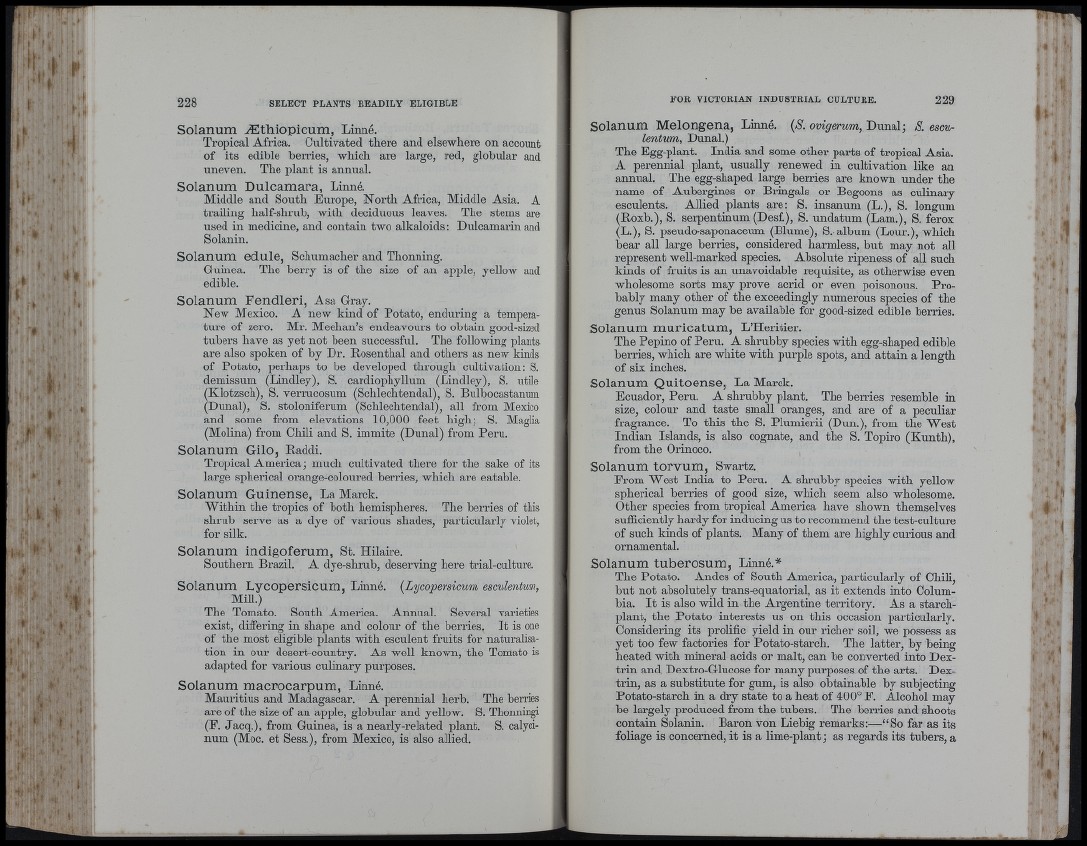
I Î
t Ï
Solanum Ætliiopicum, Linné.
Tropical Africa. Cultivated there and elsewhere on account
of its edible berries, which are large, red, globular and
uneven. Tbe plant is annual.
Solanum Dulcamara, Linné.
Middle and South Europe, North Africa, Middle Asia. A
trailing half-shrub, with deciduous leaves. The stems are
used in medicine, and contain two alkaloids ; Dulcamarin and
Solanin.
Solanum edule, Schumacher and Tlionning.
Guinea. The berry is of the size of an apple, yellow and
edible.
Solanum Fendleri, Asa Gray.
New Mexico. A new kmd of Potato, enduring a temperature
of zero. Mr. Meehan’s endeavours to obtain good-sized
tubers have as yet not been successful. The following plants
are also spoken of by Dr. Rosenthal and others as new kinds
of Potato, perhaps to be developed through cultivation: S.
demissum (Lindley), S. cardiophyllum (Lindley), S. utile
(Klotzscb), S. verrucosum (Schlecbtendal), S. Bulbocastanum
(Dunal), S. stoloniferum (Schlecbtendal), all from Mexico
and some from elevations 10,000 feet bigb; S. Maglia
(Molina) from Cbili and S. immite (Dunal) from Peru.
Solanum Gilo, Raddi.
Tropical America; much cultivated there for tlie sake of its
large spherical orange-coloured berries, whicb are eatable.
Solanum Guinense, La Marck.
Within the tropics of both hemispheres. The berries of this
shrub serve as a dye of various shades, particularly violet,
for silk.
Solanum indigoferum, St. Hilaire.
Southern Brazil. A dye-shrub, deserving here trial-culture.
Solanum Lycopersicum, Linné. (Lycopersicum esculentum,
Mill.)
The Tomato. South America. Annual. Several varieties
exist, differing in shape and colour of the berries. I t is one
of the most eligible plants with esculent fruits for naturalisation
in our desert-country. As well known, the Tomato is
adapted for various culinary purposes.
Solanum macrocarpum, Linné.
Mauritius and Madagascar. A perennial herb. The berries
are of the size of an apple, globular and yellow. S. Thonningi
(F. J acq.), from Guinea, is a nearly-related plant. S. calyci-
num (Moc. et Sess.), from Mexico, is also allied.
Solanum Melongena, Linné. {S. ovigerum, Dunal; S. esculentum,
Dunal.)
The Egg-plant. India and some otber parts of tropical Asia.
A perennial plant, usually renewed in cultivation like an
annual. Tbe egg-shaped large berries are known under the
name of Aubergines or Bringals or Begoons as culinary
esculents. Allied plants are: S. insanum (L.), S. Inn gum
(Roxb.), S. serpentinum (Desf.), S. nndatum (Lam.), S. ferox
(L.), S. pseudo-saponaceum (Blume), S. album (Lour.), wbich
bear all large bei’ries, considered harmless, bnt may not all
represent well-marked species. Absolute ripeness of all such
kinds of fruits is an unavoidable requisite, as otherwise even
wholesome sorts may prove acrid or even poisonous. Probably
many otber of the exceedingly numerous species of the
genus Solanum may be available for good-sized edible berries.
Solanum muricatum, L’Heritier.
The Pepino of Peru. A shrubby species with egg-shaped edible
berries, wbich are white with purple spots, and attain a length
of six inches.
Solanum Quitoense, La Marck.
Ecuador, Peru. A shrubby plant. Tbe berries resemble in
size, colour and taste small oranges, and are of a peculiar
fragrance. To tbis the S. Plumierii (Dun.), from the West
Indian Islands, is also cognate, and the S. Topiro (Kunth),
from the Orinoco.
Solanum torvum, Swartz.
Erom West India to Peru. A shrubby species with yellow
spherical berries of good size, which seem also wholesome.
Other species from tropical America have shown themselves
sufficiently hardy for inducing us to recommend the test-culture
of such kinds of plants. Many of them are highly curious and
ornamental.
Solanum tuberosum, Linné.*
The Potato. Andes of South America, particularly of Chili,
but not absolutely trans-equatorial, as it extends into Columbia.
I t is also wild in tbe Argentine territory. As a starch-
plant, tbe Potato interests us on tbis occasion particularly.
Considering its prolific yield in our richer soil, we possess as
yet too few factories for Potato-starch. The latter, by being
heated with mineral acids or malt, can be converted into Dextrin
and Dextro-Glucose for many purposes of the arts. Dextrin,
as a substitute for gum, is also obtainable by subjecting
Potato-starch in a dry state to a heat of 400° E. Alcohol may
be largely produced from the tubers. The berries and shoots
contain Solanin. Baron von Liebig remarks:—“ So far as its
foliage is concerned, it is a lime-plant; as regards its tubers, a